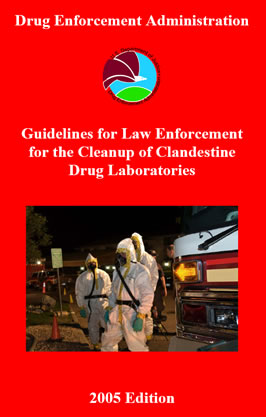
 |
|
|
 Click here to download 5MB PDF file>> |
Message from the Administrators
In 1990, the Drug Enforcement Administration (DEA), in cooperation with the Environmental protection Agency (EPA) and the U.S. Coast Guard (collaborately known as the Joint Federal Task Force), published the Guidelines for the Cleanup of Clandestine Drug Laboratories, known by those in the industry as "The Redbook." It was developed following the enactment of Section 2405 of the 1988 Anti-Drug Abuse Act. Now with more than a decade of experience, DEA, along with the assistance of the EPA, has updated the book to reflect the vast base of knowledge obtained since the first publication.
State and local law enforcement officials, environmental protection groups, and public health agencies are the primary users of the guidelines and have utilized them as a resource for safe standards of cleaning up illegal drug laboratories. The revised guidelines remain fluid to allow entities involved in these cleanup efforts to adapt to a variety of local scenarios. They also reemphasize the recommended procedures for enforcement and the safe disposal of hazardous materials.
While there is still much we can learn, the Guidelines for Law Enforcement for the Cleanup of Clandestine Drug Laboratories - 2005 Edition, represents a quantum leap forward. It characterizes much of the progress made in achieving the goals of protecting public health and the environment. The program is flexible, and provides for specific local requirements, while meeting the needs of law enforcement and ensuring safe disposal. In developing the DEA Clandestine Drug Laboratory Cleanup Program, the EPA and DEA acknowledged that residual cleanup of contaminated sites was beyond the expertise of law enforcement. DEA, however, is committed to working with state and local agencies, as well as other experts in the field of public health, to ensure that the contamination found at illegal drug laboratories is properly handled. The use of these guidelines will accomplish that goal.
As we all work together to eradicate the illegal drug trade and diversion of legitimate controlled substances, we are confident that the Guidelines for Law Enforcement for the Cleanup of Clandestine Drug Laboratories - 2005 Edition will answer many of the questions raised through lessons learned during the last decade. It also will serve as a benchmark as we move forward to ensure drug laboratories do not pose a threat to first responders, children, property owners, or the communities in which they are located.
Sincerely,
|
Sincerely,
|